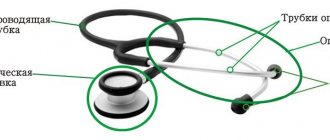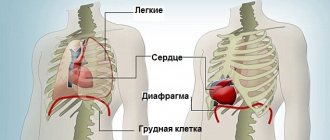Sports medicine
With regular sports activities, the human heart muscle pumps several times faster. Like any muscle structure, the heart trains.
The concept of “athletic heart” was first used in 1899 by the scientist Henschen. The specialist noticed some changes in muscle function with constant physical exercise. The muscular organ, shaped like a cone, pumps blood into the vessels thanks to rhythmic contractions. When you exercise, your heart rate increases, which means your blood pumps faster.
Why does an athletic heart develop?
To answer this question, you need to understand the basics of heartbeat. According to the Frank-Starling law, the more a muscle fiber is stretched, the more forcefully it will contract in response. During physical activity, a person's cardiovascular system is activated, and minute and stroke volumes of blood also increase. This is necessary so that as much blood as possible flows through the lungs, and a larger volume of oxygen-enriched blood reaches the skeletal muscles, which carry out the load. In turn, the more blood volume flows through the chambers of the heart, the more the myocardial fibers stretch, and, accordingly, the more force they contract. With constant training, a thickening of muscle fibers gradually forms , which is compensatory, adaptive in nature, because the greater the need for oxygen in skeletal muscles, the more blood must be enriched with oxygen in the lungs. Within a few months from the start of regular training, the athlete develops slight, uniform myocardial hypertrophy. As you train, the heart adapts more and more to physical activity and becomes more trained, which ensures the full functioning of the skeletal muscles.
At this time, the normal performance of the heart chambers also changes, which can be measured and assessed using ECG and ultrasound. The minute and stroke volumes of blood increase (the amount of blood flowing through the heart per minute and per heart beat) - more than 5 liters per minute and more than 70 ml per beat, respectively. At the same time, due to adaptive mechanisms in the cardiac muscle, the frequency of electrical impulses through the myocardium decreases, which is manifested by a decrease in heart rate per minute (about 50 beats per minute, compared to 70-80 beats per minute in an untrained person). A decrease in heart rate (bradycardia) under conditions of systematic exercise has a very beneficial effect on the heart muscle itself, because with a rapid heartbeat (which is typical for an ordinary person with a pulse of 100-120 per minute after exercise), there is an increased need for oxygen for the heart muscle.
Compensatory hypertrophy itself is of enormous importance for performing professional sports, because providing skeletal muscles with oxygen during speed or power loads is the most important factor in the adaptation of the athlete’s body. That is, in essence, compensatory hypertrophy is a favorable condition relative to the entire organism, however, with the further development of hypertrophy, when the heart enlarges two or more times (compared to a normal heart), cardiac diseases may appear. So, in particular, with a hypertrophied heart, rhythm disturbances, arterial hypertension, angina of a secondary nature, etc. often occur.
In the course of studies that are constantly carried out to assess the physical condition of athletes, it has been revealed and proven that upon cessation of training, a gradual weakening of compensatory mechanisms in the cardiac muscle is possible with the heart returning to normal, normal sizes. In general, minor myocardial hypertrophy does not pose any threat to life or health if the size of the heart does not exceed permissible limits. As soon as an athlete’s examination reveals criteria that significantly exceed the indicators of physiological hypertrophy, and complications arise, he should engage in professional sports.
Norms and pathologies of heart rate in athletes
You can calculate your maximum heart rate yourself. There are several different templates for calculation.
A simple calculation example:
- for men: subtract the current age from the number 214 and multiply by 0.8;
- for women: subtract your current age from 209 and multiply by 0.7.
Sample for calculating maximum heart rate by weight:
- for women: heart rate = 210 – ½ age – 5% of body weight;
- for men: heart rate = 210 – ½ age – 5% of body weight + 4;
- Heart rate for fat burning: HR = 60–80% of maximum heart rate (preferably 70%).
Another way to find out what your maximum heart rate is is to try it out. The ideal is to choose a steep hill that you will run up and down (optimally it should be at least 200-300 m uphill). Carry a heart rate meter with you. Run up and down the hill 5-6 times. The highest heart rate you measure while running will be your maximum. Anything higher is pathological and unsafe for health!
What sports develop the “athlete’s heart”?
In order for the specified adaptive mechanisms to form in the heart muscle, a person must engage in certain sports for a long time and professionally, with regular training. Typically, an athletic heart is formed when engaging in high-speed sports that require great endurance. These types of sports include long-distance running, skiing, triathlon, and cycling.
In more powerful sports (weightlifting, wrestling, boxing, group games, etc.), hypertrophy develops rarely, in isolated cases, and then, as a rule, when the athlete is predisposed to cardiac pathology.
We are developing further
Don't forget that training your heart and developing your endurance should receive equal attention. All stages of increasing the intensity of exercises must be completed gradually, slowly, so as not to harm the heart and blood vessels and develop their endurance. The key to success is regularity. If you go to the pool or ride a bike several times a week, then morning exercises should be done daily. In addition to the previously recommended shaking and turning, we recommend a number of exercises for the heart and blood vessels:
- Walking on your toes, raising your knees high.
- Hands above your head in a lock, legs apart. Deep bends to the sides.
- Hands to the sides, bring them together, slap your shoulders.
- Rotation of the arms forward - up - back and vice versa.
- Simulation of cycling in a lying position.
- Cross-shaped movements of the legs at a height of 30-40 centimeters from the floor in a lying position.
We remember: it is not the number of exercises and the intensity of the load that is important, but the regularity. The load should increase gradually. After it, relaxation is necessary so that the muscle fibers increase, and the heart muscle and blood vessels are strengthened, and their endurance increases.
Is it possible to develop a sports heart through physical education?
When engaging in physical activity as usual (exercise, jogging, Nordic walking, swimming), hypertrophy does not develop, but adaptation mechanisms in the heart are still formed. Thus, in people who regularly and for a long time engage in physical exercise, the heart rate also decreases and the minute volume of blood increases, but a clearly defined thickening of muscle fibers does not occur. In order for the “athlete’s heart” to be formed, long-term daily training that develops endurance is necessary, lasting at least 3-4 hours of intensive training per day.
Exercises to train your heart
In fact, the range of such exercises is quite wide. Heart training is carried out through cardio and aerobic exercise. You can go jogging, ride a bike for at least half an hour a day, jump rope, swim in the pool, do aerobics and step, dance, or just take walks for 20 minutes in the evening, and give up the elevator. It is recommended to adhere to the following rules:
- The optimal heart rate is one hundred twenty to one hundred thirty beats (not higher than 130 and lower than 110).
- You cannot arrange training sessions lasting more than an hour (for weak blood vessels - 30 minutes).
- Conduct these classes two or three times during the week.
Heart training by running is also beneficial. Don't turn it into a routine. Jogging three or four times a week for 20 minutes, monitor your condition. If you feel any discomfort, go for a walk.
“Athlete's heart” – a disease or a norm?
For a long time after the start of training, the athlete feels satisfactory. His tolerance to physical activity increases, and he tolerates even intense training quite well, without tachycardia and without shortness of breath. This is precisely due to the fitness of the heart muscle, which, due to hypertrophy, is capable of better satisfying the body’s needs during exercise.
However, as hypertrophy increases, especially if the intensity of training increases, the athlete may develop certain clinical manifestations. Thus, when the size of the heart increases two or more times compared to the norm, an athlete may experience the so-called sports heart syndrome, which is manifested by shortness of breath, a feeling of irregular heartbeat, a feeling of the heart hitting the anterior chest, and dizziness. Sometimes fainting may occur. As hypertrophy increases, various heart rhythm disturbances are possible (AV block, atrial fibrillation-flutter, ventricular extrasystole), which can lead to loss of consciousness. Due to the fact that the mass of the myocardium has become larger, and the growth of the coronary arteries (these are the arteries that supply oxygen to the heart muscle itself) does not occur, the heart itself begins to suffer from a lack of oxygen. Myocardial ischemia develops. With a very high load that is unusual for an athlete, myocardial infarction may occur.
Typically, such serious health problems develop if the athlete has already identified changes in the cardiovascular system, and he continues to train as before.
Contraindications to playing sports with the syndrome
A temporary cessation of physical activity for at least five to six years will help stop the process of forming a sports heart. As a result, due to the reduction of contractile muscle fibers, part of the connective tissue may be destroyed. Of course, it will not be possible to cover all the damage, but reducing its volume to 3% is quite possible.
Athletes who cannot stop the training process for such a long period of time are recommended to take the following actions:
- Review your training program. It is necessary to structure the training in such a way that it increases the strength of heart contractions and endurance. The number and speed of approaches, their intensity should be reduced to the maximum.
- Buy a heart rate monitor. The heart rate monitor is designed to ensure that the pulse does not touch the fat-burning zone even during the most intense moments of training.
Strength all-around and some other types of strength sports are absolutely contraindicated in case of sports heart syndrome.
Diagnostic criteria
In order to identify a mature sports heart, each athlete must undergo an annual cardiac ultrasound (echocardioscopy, echo-CS). This technique allows you to reliably estimate the volume of the heart, stroke volume of blood, the size of the atria and ventricles, as well as the thickness of the myocardial walls. If these indicators are much higher than normal, the sports doctor should decide whether to stop or reduce the intensity of training. In addition, conducting a simple Harvard step test (based on calculating heart rate after exercise) can help in assessing the fitness of the heart muscle.
athlete's heart on echocardiography (ultrasound)
In addition to Echo-CS, all athletes are required to undergo an ECG once every six months. On the ECG, you can see indirect signs of left ventricular hypertrophy (deviation of the electrical axis of the heart (EOS) to the left, disturbances in repolarization processes, sometimes along all walls of the left ventricle, as well as conduction disturbances in the atrioventricular node and/or the His bundle system).
signs of left ventricular hypertrophy on the ECG
Measures to identify pathology
In case of complaints about the functioning of the heart, it is necessary to undergo examinations and consult a doctor. Diagnosis includes echocardiography, ECG and stress testing. Additionally, 24-hour Holter ECG monitoring or stress echocardiography are used. It is impossible to diagnose athlete's heart syndrome on your own.
Often signs of pathology are discovered during examination of other organs or during routine screening. It is important to be able to distinguish this syndrome from disorders caused by similar manifestations and posing a threat to life, for example, coronary artery disease.
No specific therapy is required if there are no:
- pain;
- fainting;
- ischemia;
- arrhythmia;
- increased fatigue;
- conduction disturbance.
In this case, the changes are considered physiological. As a means of prevention, the following may be prescribed:
- Beta blockers.
- Adaptogens.
- Vitamin and mineral complexes.
- Nutritional supplements.
In case of serious cardiac dysfunction, complex treatment is carried out using cardiotonics, antihypertensive and antiarrhythmic drugs.
Proper nutrition plays an important role, especially for young athletes. The menu should contain a sufficient amount of protein, be rational and quite high in calories. You should eat foods rich in vitamins and minerals.
The diet must include the following products:
In advanced cases, surgical intervention and complete abstinence from sports activities are indicated, sometimes requiring the installation of a pacemaker.
Should an athlete's heart be treated?
As mentioned above, myocardial hypertrophy during professional sports can be leveled out independently after the cessation of intense training. Of course, no athlete can imagine his future life without playing sports, but with the development of severe myocardial hypertrophy, intense endurance training is strictly contraindicated. However, light physical exercise is quite acceptable if there are no obvious contraindications (hypertension, previous heart attacks and strokes, hemodynamically significant heart rhythm disturbances).
Myocardial hypertrophy without these diseases does not require drug treatment, but in the latter case, regular monitoring by a doctor with medications taken on an ongoing basis is required.
Strengthening the heart and folk recipes
It is very important that the heart muscle receives the necessary vitamins; training alone cannot do this. Here are some tips from healers:
- Mix chopped dried apricots, walnuts, figs, lemon with peel, raisins, honey. Take 250 grams of everything. Keep refrigerated. Take a tablespoon three times a day.
- Take a tablespoon of hawthorn for one and a half glasses of water and boil for thirty minutes. Drink a quarter glass three times before meals.
- Take 10 grams of lemon balm, St. John's wort, birch leaves, 30 grams of fireweed. Steam a tablespoon per 300 ml of water. Take a glass three times a day.
- Place a tablespoon of buckwheat in 500 ml of water and leave for 2 hours. Drink one glass three times.
- Pour five tablespoons of rosemary herb into 100 ml of vodka and leave for 7 days. Take twenty-five drops three times half an hour before meals.
Be healthy!
Sports heart in childhood
A child involved in professional sports has some characteristics and differences from an adult. This is due to a discrepancy in the growth of internal organs (including the heart) compared to the musculoskeletal system, as well as a hormonal “explosion” in adolescents (especially girls). After just 2-3 months of daily strength and speed training, the child experiences adaptive changes in the cardiovascular and respiratory systems. In other words, the rudiments of myocardial hypertrophy begin to form already at this time.
Before sending a child to big sports, parents should carefully take care of a full medical examination. Regarding the cardiovascular system, an ECG, ultrasound of the heart and Rufier's test are mandatory. Those children who have begun to engage in professional sports should conduct the same studies annually and visit a cardiologist.
Children who do not experience any clinical manifestations during or after exercise (loss of consciousness, darkness before the eyes, stupor, sensations of interruptions in the heart, pain in the chest) can continue playing sports. Otherwise, intense training is contraindicated.
Why is pain during exercise dangerous?
Correctly selected physical exercises are one of the methods for preventing diseases of the cardiovascular system. However, there are conditions when even a slight load causes pain in the heart when playing sports:
- Coronary heart disease (angina pectoris) is caused by a violation of blood transport to the myocardium through the narrowed lumen of the coronary vessels. This disease develops in people with atherosclerosis. An attack of pain is characterized by retrosternal localization, radiation to the left arm and shortness of breath.
The problem of symptoms in athletes is associated with increased myocardial mass, which leads to increased nutrient requirements. During intense exercise, the need for an adequate supply of oxygen increases, causing a vicious cycle.
- Hypertrophic cardiomyopathy is a non-inflammatory lesion of the myocardial muscle mass, which is characterized by an increase in the number of fibers with a decrease in the volume of the heart chambers, resulting in a decrease in the amount of ejected blood.
- Uncontrolled use of hormonal and anabolic drugs . Heart pain after bodybuilding is often associated with the intake of proteins and testosterone, which help build skeletal muscle. However, the use of uncertified products in unregulated doses is accompanied by a delay in the development of internal organs, especially the heart, which does not have time to adapt to ensure sufficient blood supply.
In addition, a significant increase in the volume of the heart cavities develops arrhythmia and congestion in the chambers with the formation of a blood clot. Such processes lead to thromboembolism - blockage of the lumen of a vessel with a blood clot, which requires urgent treatment.
What measures to take?
To minimize the deterioration of heart function, you should:
- Stop doing any physical activity. You need to sit down and lower your legs down - this will reduce the load on the heart muscle. Unbutton your clothes. Provide fresh air.
- Take a sublingual nitroglycerin tablet or one dose of nitrospray. If the pain does not stop, take another additional nitroglycerin tablet after 5 minutes.
- Call an ambulance immediately if the attack is the first or appears at rest, or the pain is severe and does not stop.
The heart beats less often in children or adolescent athletes: is physical activity acceptable?
The mechanism of its appearance in children and adolescents differs little from the processes in the adult body. The criterion for identifying bradycardia is specific. At different ages, different thresholds for normal heart rate are set.
As in an adult, physiological childhood bradycardia does not require medical intervention . The body adapts to the stress and the child can play sports.
However, if your heart rate decreases significantly, you should consult a doctor.
In a child, alarming symptoms include drowsiness, fatigue, dizziness, pale skin, shortness of breath, and cold sweating. Such signs can appear even during physical education lessons.
Constant bradycardia is dangerous by limiting the supply of oxygen to the child’s brain, which slows down the development of all organs. A significant load on the myocardium can cause its exhaustion.
For a child with bradycardia, horseback riding, cycling, gymnastics, karate and judo, alpine skiing, and diving are contraindicated. You should not get carried away with bodybuilding. We recommend swimming, golf, volleyball, rowing. Moderate exercise in race walking and classic skiing is beneficial.
Serious exercise poses a risk of developing bradycardia. In most cases, it does not pose a health hazard, but requires constant monitoring. If signs of pathological bradycardia appear, you should consult a cardiologist. Timely measures taken will help avoid serious heart problems.
Source: oserdce.com
Case from practice
Parents came for a consultation with a 13-year-old child who complained of stabbing pain in the heart area.
Appeared several months ago; previously I was ill only with colds. When collecting anamnesis, it became clear that an unpleasant sensation appears after eating, especially when eating fatty and heavy foods. It is accompanied by symptoms such as nausea and sometimes vomiting. No abnormalities were found on the ECG. A consultation with a gastroenterologist and an ultrasound of the liver showed a violation of the outflow of bile from the bladder and its inflammation. The boy was referred to a gastroenterologist.











